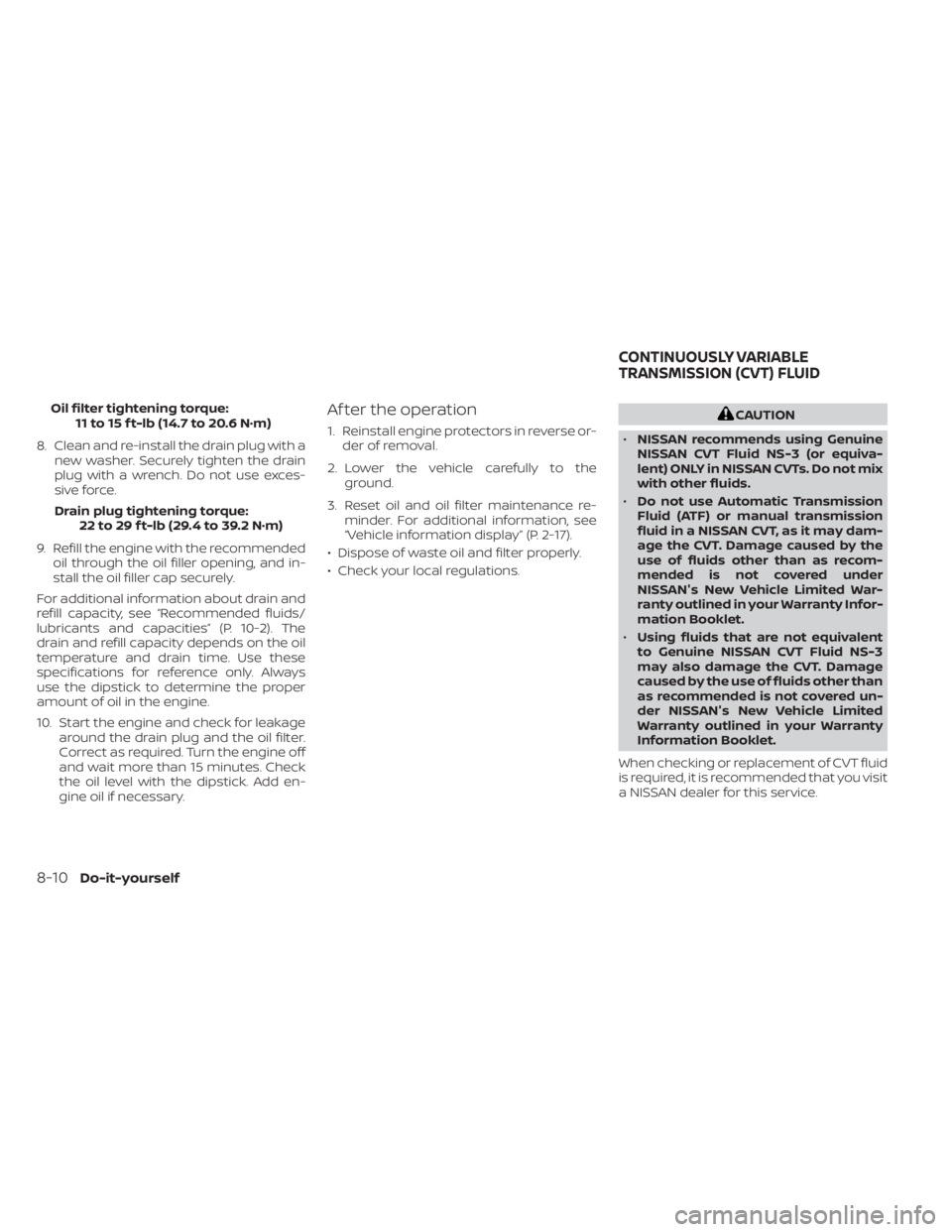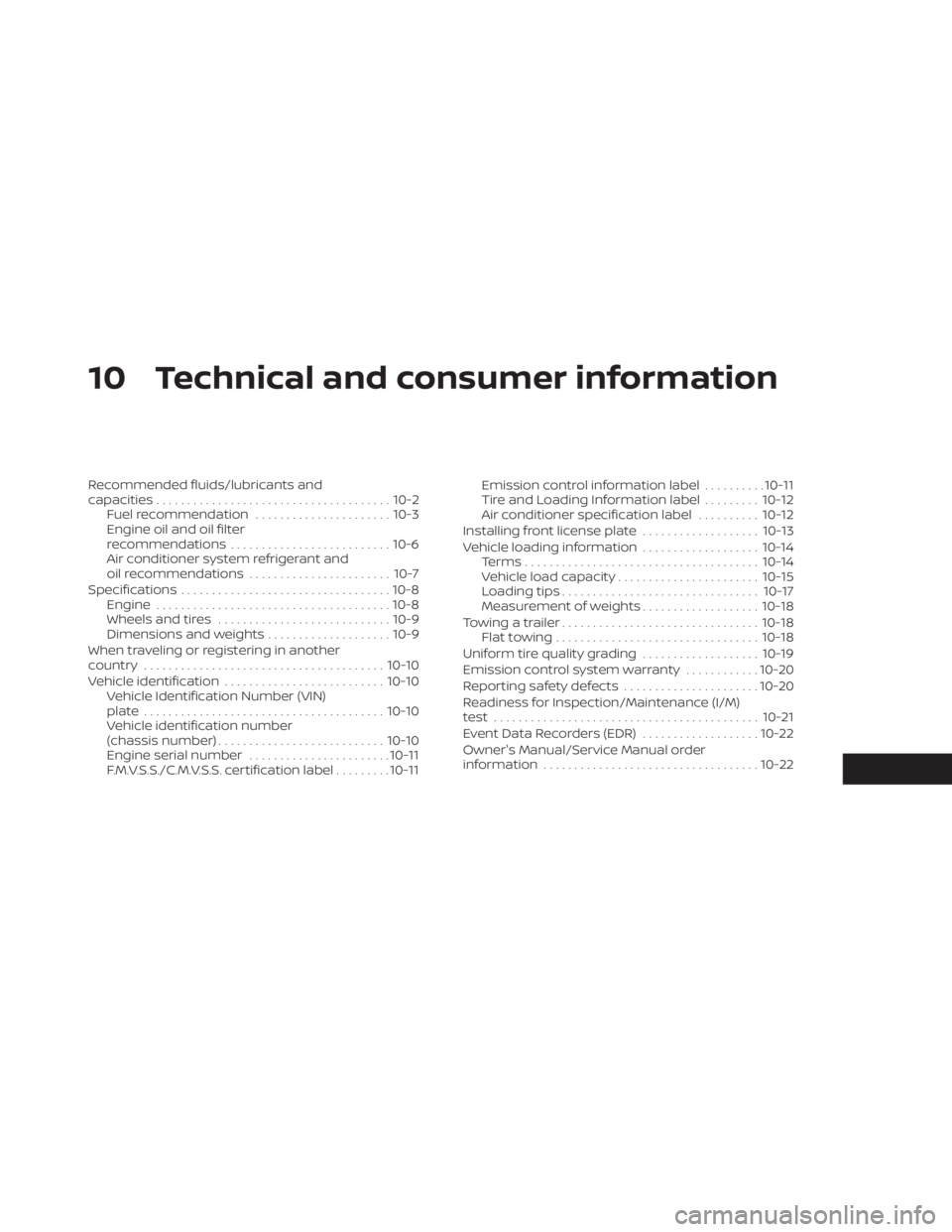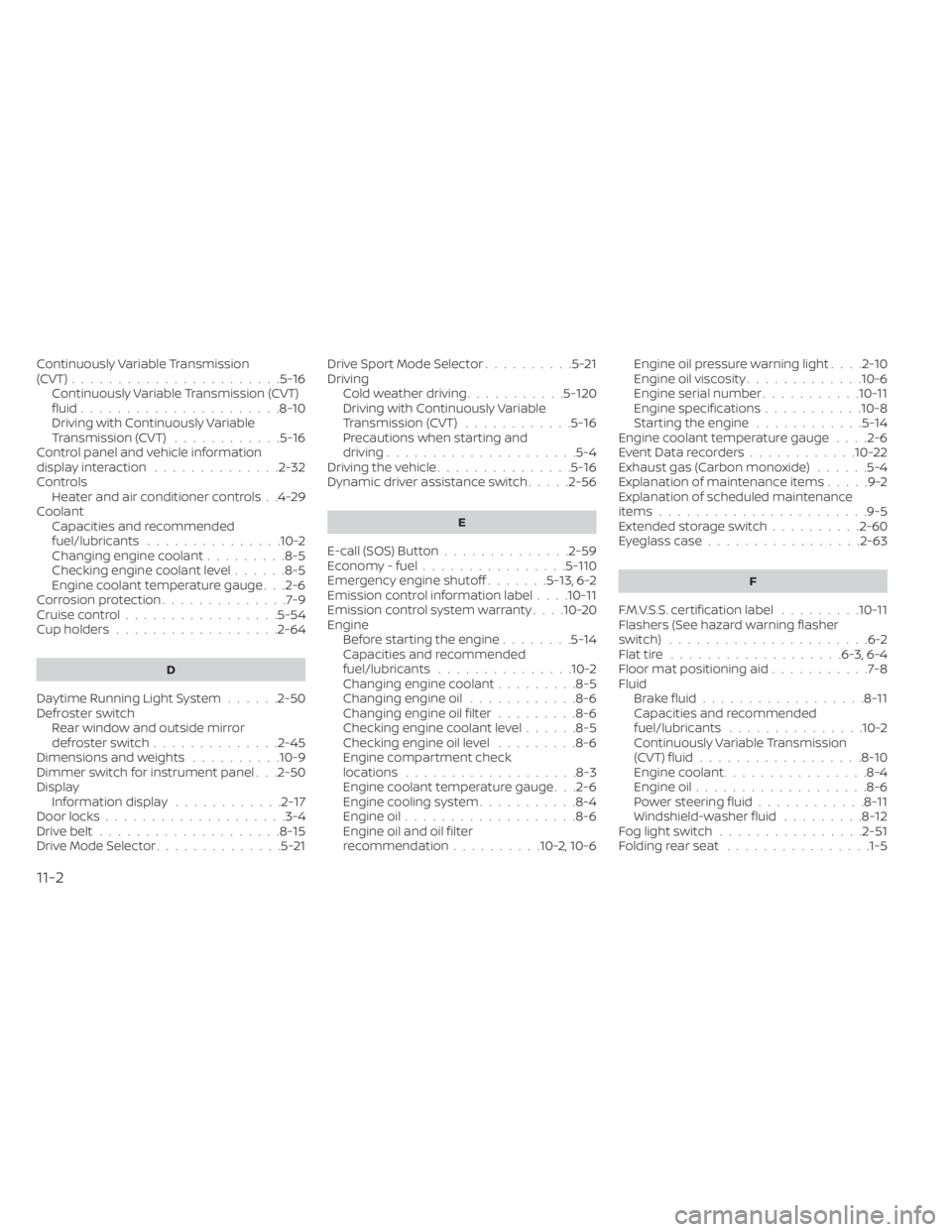oil capacities NISSAN MAXIMA 2021 Owner´s Manual
[x] Cancel search | Manufacturer: NISSAN, Model Year: 2021, Model line: MAXIMA, Model: NISSAN MAXIMA 2021Pages: 476, PDF Size: 3.32 MB
Page 386 of 476

Oil filter tightening torque:11 to 15 f t-lb (14.7 to 20.6 N·m)
8. Clean and re-install the drain plug with a new washer. Securely tighten the drain
plug with a wrench. Do not use exces-
sive force.
Drain plug tightening torque: 22 to 29 f t-lb (29.4 to 39.2 N·m)
9. Refill the engine with the recommended oil through the oil filler opening, and in-
stall the oil filler cap securely.
For additional information about drain and
refill capacity, see “Recommended fluids/
lubricants and capacities” (P. 10-2). The
drain and refill capacity depends on the oil
temperature and drain time. Use these
specifications for reference only. Always
use the dipstick to determine the proper
amount of oil in the engine.
10. Start the engine and check for leakage around the drain plug and the oil filter.
Correct as required. Turn the engine off
and wait more than 15 minutes. Check
the oil level with the dipstick. Add en-
gine oil if necessary.Af ter the operation
1. Reinstall engine protectors in reverse or-der of removal.
2. Lower the vehicle carefully to the ground.
3. Reset oil and oil filter maintenance re- minder. For additional information, see
“Vehicle information display” (P. 2-17).
• Dispose of waste oil and filter properly.
• Check your local regulations.
CAUTION
• NISSAN recommends using Genuine
NISSAN CVT Fluid NS-3 (or equiva-
lent) ONLY in NISSAN CVTs. Do not mix
with other fluids.
• Do not use Automatic Transmission
Fluid (ATF) or manual transmission
fluid in a NISSAN CVT, as it may dam-
age the CVT. Damage caused by the
use of fluids other than as recom-
mended is not covered under
NISSAN's New Vehicle Limited War-
ranty outlined in your Warranty Infor-
mation Booklet.
• Using fluids that are not equivalent
to Genuine NISSAN CVT Fluid NS-3
may also damage the CVT. Damage
caused by the use of fluids other than
as recommended is not covered un-
der NISSAN's New Vehicle Limited
Warranty outlined in your Warranty
Information Booklet.
When checking or replacement of CVT fluid
is required, it is recommended that you visit
a NISSAN dealer for this service.
CONTINUOUSLY VARIABLE
TRANSMISSION (CVT) FLUID
8-10Do-it-yourself
Page 439 of 476

10 Technical and consumer information
Recommended fluids/lubricants and
capacities...................................... 10-2
Fuel recommendation ......................10-3
Engine oil and oil filter
recommendations .......................... 10-6
Air conditioner system refrigerant and
oil recommendations ....................... 10-7
Specifications .................................. 10-8
Engine ...................................... 10-8
Wheels and tires ............................ 10-9
Dimensions and weights ....................10-9
When traveling or registering in another
country ....................................... 10-10
Vehicle identification .......................... 10-10
Vehicle Identification Number (VIN)
plate ....................................... 10-10
Vehicle identification number
(chassis number) ........................... 10-10
Engine serial number .......................10-11
F.M.V.S.S./C.M.V.S.S. certification label .........10-11 Emission control information label
..........10-11
Tire and Loading Information label .........10-12
Air conditioner specification label ..........10-12
Installing front license plate ...................10-13
Vehicle loading information ...................10-14
Terms ...................................... 10-14
Vehicle load capacity ....................... 10-15
Loading tips ................................ 10-17
Measurement of weights ...................10-18
Towing a trailer ................................ 10-18
Flat towing ................................. 10-18
Uniform tire quality grading ...................10-19
Emission control system warranty ............10-20
Reporting safety defects ......................10-20
Readiness for Inspection/Maintenance (I/M)
test ........................................... 10-21
Event Data Recorders (EDR) ...................10-22
Owner's Manual/Service Manual order
information ................................... 10-22
Page 440 of 476

The following are approximate capacities. The actual refill capacities may be slightly different. When refilling, follow the procedure
described in the “Do-it-yourself ” section to determine the proper refill capacity.
Fluid typeCapacity (approximate)
Recommended Fluids/Lubricants
Metric
Measure US
Measure Imperial
Measure
Fuel 68 L 18 gal 15 gal • For additional information, see “Fuel recommendation” (P. 10-3).
Engine oil*1
Drain and refill
*1: For additional information, see
“Engine oil” (P. 8-6). With oil filter
change 4.8 L 5-1/8 qt 4-1/4 qt • Genuine “NISSAN Motor Oil 0W-20 SN” (or equivalent) is recom-
mended.
• If the above motor oil (or engine oil) is not available, a synthetic
0W-20 GF-5 SN motor oil (or engine oil) may be used. Damage
caused by the use of motor oil (or engine oil) other than as rec-
ommended is not covered under NISSAN’s New Vehicle Limited
Warranty. For additional information, see “Engine oil and oil filter
recommendation” (P. 10-6).
Without oil
filter change 4.5 L 4-3/4 qt 4 qt
Engine coolant
with reservoir 9.2 L 2-3/8 gal 2 gal• Pre-diluted Genuine NISSAN Long Life Antifreeze/Coolant (blue)
or equivalent
Continuously Variable Transmission (CVT) fluid — — — • Genuine NISSAN CVT Fluid NS-3
• NISSAN recommends using Genuine NISSAN CVT Fluid NS-3 (or
equivalent) ONLY in NISSAN CVTs. Do not mix with other fluids.
Using fluids that are not equivalent to Genuine NISSAN CVT Fluid
NS-3 may damage the CVT. Damage caused by the use of fluids
other than as recommended is not covered under NISSAN's
New Vehicle Limited Warranty outlined in your Warranty Infor-
mation Booklet.
Power Steering Fluid (PSF) — — — • Genuine NISSAN E-PSF or equivalent.
• Use of a power steering fluid other than Genuine NISSAN E-PSF
may prevent the power steering system from operating prop-
erly.
Brake fluid reservoir 0.49 L 1/2 qt 3/8 qt • Genuine NISSAN Super Heavy Duty Brake Fluid*2 or equivalent
DOT 3
*2: Available in mainland U.S.A through a NISSAN dealer.
Multi-purpose grease — — — • NLGI No. 2 (Lithium Soap base)
RECOMMENDED FLUIDS/
LUBRICANTS AND CAPACITIES
10-2Technical and consumer information
Page 444 of 476

ENGINE OIL AND OIL FILTER
RECOMMENDATIONS
Selecting the correct oil
It is essential to choose the correct grade,
quality and viscosity engine oil to ensure
satisfactory engine life and performance.
For additional information, see “Recom-
mended fluids/lubricants and capacities”
(P. 10-2). NISSAN recommends the use of an
energy conserving oil in order to improve
fuel economy.Select only engine oils that meet the
American Petroleum Institute (API) certifi-
cation or International Lubricant Standard-
ization and Approval Committee (ILSAC)
certification and SAE viscosity standard.
These oils have the API certification mark
on the front of the container. Oils which do
not have the specified quality label should
not be used as they could cause engine
damage.
Oil additives
NISSAN does not recommend the use of oil
additives. The use of an oil additive is not
necessary when the proper oil type is used
and maintenance intervals are followed.
Oil which may contain foreign matter or
has been previously used should not be
used.
Oil viscosity
The engine oil viscosity or thickness
changes with temperature. Because of
this, it is important to select the engine oil
viscosity based on the temperatures at
which the vehicle will be operated before
the next oil change. Choosing an oil viscos-
ity other than that recommended could
cause serious engine damage.
Selecting the correct oil filter
Your new NISSAN vehicle is equipped with a
high-quality Genuine NISSAN oil filter. When
replacing, use a Genuine NISSAN oil filter or
its equivalent for the reason described in
“Change intervals.”
LTI2051
10-6Technical and consumer information
Page 461 of 476

11 Index
A
Active noise cancellationActive sound enhancement......5-121Active Ride Control (ARC).........5-116Air bag (See supplemental restraint
system).................... .1-43Air bag system
Front (See supplemental front impact air
bag system)
................1-51Air bag warning light.........1-64, 2-10Air bag warning light,
supplemental.............1-64, 2-10Air cleaner...................8-16Air cleaner housing filter..........8-16Air conditionerAir conditioner operation........4-29Air conditioner specification label. .10-12Air conditioner system refrigerant
recommendations.........10-2, 10-7Air conditioner system refrigerant and oil
recommendations.........10-2, 10-7Heater and air conditioner (automatic)
(if so equipped)..............4-28Heater and air conditioner controls.4-29Servicing air conditioner........4-32Alarm system (See vehicle security
system)................... .2-39Anchor point locations...........1-27Antenna....................4-32Antifreeze...................5-120
Armrests.....................1-7Autolight switch...............2-46Automatic
Automatic power window switch. . .2-67Automatic anti-glare inside mirror. . . .3-27Automatic door locks.............3-6Automatic Emergency Braking
(AEB)....................2-11,2-15Automatic Emergency Braking (AEB) with
Pedestrian Detection............5-85
B
Battery.................5- 120, 8-13Charge warning light...........2-10Battery replacement.............8-21Key fob...................8-21NISSAN Intelligent Key®.........8-22Before starting the engine.........5-14Belt (See drive belt)..............8-15Blind Spot Warning (BSW)..........5-36Booster seats.................1-40Brake
Brake fluid..................8-11Brake light (See stop light).......8-24Brake warning light............2-9Brake wear indicators.......2-16,8-18Parking brake operation.........5-21Self-adjusting brakes...........8-18Brake fluid...................8-11
Brakes.....................8-18Break-in schedule.............5-109Brightness controlInstrument panel.............2-50Bulb check/instrument panel........2-9Bulb replacement..............8-24
C
C.M.V.S.S. certification label.........10-11Capacities and recommended
fuel/lubricants................10-2Car phone or CB radio...........4-33Cargo (See vehicle loading
information)................ .10-14Check tire pressure.............2-29Child restraints.......1-20,1-21,1-22,1-24LATCH (Lower Anchors and Tethers for
CHildren) System.............1-24Precautions on child
restraints...........1-29,1-35, 1-40Top tether strap anchor point
locations..................1-27Child safety rear door lock..........3-6Cleaning exterior and interior.....7-2,7-5Climate control seat switch........2-52Cold weather driving............5-120Console box................. .2-63Console light.................2-72
Page 462 of 476

Continuously Variable Transmission
(CVT).......................5-16Continuously Variable Transmission (CVT)
fluid......................8-10Driving with Continuously Variable
Transmission (CVT)............5-16Control panel and vehicle information
display interaction..............2-32ControlsHeater and air conditioner controls. .4-29CoolantCapacities and recommended
fuel/lubricants
...............10-2Changing engine coolant.........8-5Checking engine coolant level......8-5Engine coolant temperature gauge. . .2-6Corrosion protection..............7-9Cruise control................ .5-54Cup holders................. .2-64
D
Daytime Running Light System......2-50Defroster switch
Rear window and outside mirror
defroster switch
..............2-45Dimensions and weights..........10-9Dimmer switch for instrument panel. . .2-50DisplayInformation display............2-17Door locks................... .3-4Drive belt....................8-15Drive Mode Selector..............5-21
Drive Sport Mode Selector..........5-21Driving
Cold weather driving...........5-120Driving with Continuously Variable
Transmission (CVT)............5-16Precautions when starting and
driving.................... .5-4Driving the vehicle...............5-16Dynamic driver assistance switch.....2-56
E
E-call (SOS) Button..............2-59Economy - fuel................5-110Emergency engine shutoff.......5-13,6-2Emission control information label. . . .10-11Emission control system warranty. . . .10-20Engine
Before starting the engine........5-14Capacities and recommended
fuel/lubricants...............10-2Changing engine coolant.........8-5Changing engine oil............8-6Changing engine oil filter.........8-6Checking engine coolant level......8-5Checking engine oil level.........8-6Engine compartment check
locations.................. .8-3Engine coolant temperature gauge. . .2-6Engine cooling system...........8-4Engine oil...................8-6Engine oil and oil filter
recommendation..........10-2, 10-6
Engine oil pressure warning light. . . .2-10Engine oil viscosity.............10-6Engine serial number...........10-11Engine specifications...........10-8Starting the engine............5-14Engine coolant temperature gauge. . . .2-6Event Data recorders............10-22Exhaust gas (Carbon monoxide)......5-4Explanation of maintenance items.....9-2Explanation of scheduled maintenance
items...................... .9-5Extended storage switch..........2-60Eyeglass case.................2-63
F
F.M.V.S.S. certification label.........10-11Flashers (See hazard warning flasher
switch)......................6-2Flat tire.................. .6-3, 6-4Floor mat positioning aid...........7-8Fluid
Brake fluid..................8-11Capacities and recommended
fuel/lubricants...............10-2Continuously Variable Transmission
(CVT) fluid..................8-10Engine coolant................8-4Engine oil.................. .8-6Power steering fluid............8-11Windshield-washer fluid.........8-12Fog light switch................2-51Folding rear seat................1-5
11-2
Page 465 of 476

N
NISSAN Intelligent Key®..........3-2,3-7NISSAN Intelligent Key® battery discharge
indicator.....................5-13NISSAN Vehicle Immobilizer
System..................2-41, 5-14NissanConnect® Owner's Manual......4-2
O
Octane rating (See fuel octane rating). .10-5Odometer................... .2-5Oil
Capacities and recommended
fuel/lubricants
...............10-2Changing engine oil............8-6Changing engine oil filter.........8-6Checking engine oil level.........8-6Engine oil.................. .8-6Engine oil and oil filter
recommendation..........10-2, 10-6Engine oil viscosity.............10-6Outside mirror control............3-28Outside mirrors................3-28Overhead sunglasses holder........2-63Overheat
If your vehicle overheats.........6-11Owner's manual order form........10-22Owner's manual/service manual order
information................. .10-22
P
Parking
Parking brake operation.........5-21Parking/parking on hills.........5-111Parking brake..................5-21Personal lights.................2-73PowerPower door locks..............3-6Power outlet................2-59Powerrearwindows...........2-66Power steering fluid............8-11Power steering system.........5-112Power windows..............2-65Rear power windows...........2-66Power outlet................. .2-59Power steering................5-112Power steering fluid..............8-11Precautions
Maintenance precautions.........8-2Precautions on booster
seats...............1-29, 1-35, 1-40Precautions on child
restraints............1-29,1-35, 1-40Precautions on seat belt usage.....1-11Precautions on supplemental restraint
system................... .1-43Precautions when starting and driving.5-4Push starting..................6-11
R
Radio
Car phone or CB radio..........4-33Rain-sensing auto wiper system.....2-44Readiness for inspection maintenance (I/M)
test...................... .10-21Rear Automatic Braking (RAB).......5-80Rear Cross Traffic Alert (RCTA).......5-45Rear Door Alert.........2-26,2-27,2-58Rear power sunshade............2-70Rear power windows.............2-66Rear seat.................... .1-5Rear sun shade................2-70Rear window and outside mirror defroster
switch..................... .2-45RearView Monitor................4-3Recommended Fluids............10-2Recorders
Event Data................ .10-22Refrigerant recommendation. . . .10-2, 10-7Registering a vehicle in another
country.................... .10-10Remote Engine Start..........3-18,5-15Reporting safety defects (US only). . . .10-20
S
Safety
Child safety rear door lock.........3-6Child seat belts.....1-22,1-29, 1-35, 1-40Reporting safety defects (US only). .10-20
11-5
Page 474 of 476

FUEL RECOMMENDATION:
NISSAN recommends the use of unleaded
premium gasoline with an octane rating of
at least 91 AKI (Anti-Knock Index) number
(Research octane number 96). If unleaded
premium gasoline is not available, you may
use unleaded regular gasoline with an oc-
tane rating of at least 87 AKI number (Re-
search octane number 91), but you may
notice a decrease in performance.
CAUTION
• Using a fuel other than that specified
could adversely affect the emission
control system, and may also affect
the warranty coverage.
• Under no circumstances should a
leaded gasoline be used, because
this will damage the three-way
catalyst.
• Do not use a fuel containing more
than 15% ethanol in your vehicle. Your
vehicle is not designed to run on a
fuel containing more than 15% etha-
nol. Using a fuel containing more
than 15% ethanol in a vehicle not spe-
cifically designed for a fuel contain-
ing more than 15% ethanol can ad-
versely affect the emission control devices and systems of the vehicle.
Damage caused by such fuel is not
covered by the NISSAN New Vehicle
Limited Warranty.
• Do not use fuel that contains the oc-
tane booster methylcyclopentadi-
enyl manganese tricarbonyl (MMT).
Using fuel containing MMT may ad-
versely affect vehicle performance
and vehicle emissions. Not all fuel
dispensers are labeled to indicate
MMT content, so you may have to
consult your gasoline retailer for
more details. Note that Federal and
California laws prohibit the use of
MMT in reformulated gasoline.
• U.S. government regulations require
ethanol dispensing pumps to be
identified by a small, square, orange
and black label with the common ab-
breviation or the appropriate per-
centage for that region.
For additional information, see “Recom-
mended fluids/lubricants and capacities”
(P. 10-2).
ENGINE OIL RECOMMENDATION:
For additional information, see “Recom-
mended fluids/lubricants and capacities”
(P. 10-2).
COLD TIRE PRESSURE:
Refer to the Tire and Loading Information
label.
The label is typically located on the driver
side center pillar or on the driver's door. For
additional information, see “Wheels and
tires” (P. 8-26).
RECOMMENDED NEW VEHICLE
BREAK-IN PROCEDURE:
During the first 1,200 miles (2,000 km) of
vehicle use, follow the break-in procedure
recommendations for the future reliability
and economy of your new vehicle. For ad-
ditional information, see “Break-in sched-
ule” (P. 5-109). Failure to follow these recom-
mendations may result in vehicle damage
or shortened engine life.
GAS STATION INFORMATION